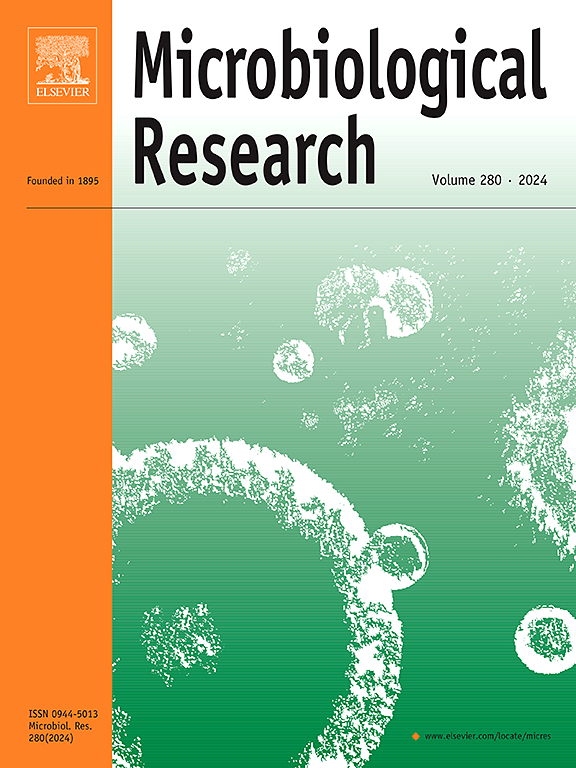Pseudomonas syringae exacerbates apple replant disease caused by Fusarium
IF 6.1
1区 生物学
Q1 MICROBIOLOGY
引用次数: 0
Abstract
Apple replant disease (ARD) causes significant economic losses globally, including in China. Analyzing the causes of this replant disease from the perspective of rhizosphere microecology is therefore essential. In this study, we examined rhizosphere soils from apple trees subjected to continuous cropping. The mechanisms underlying ARD were elucidated through high-throughput sequencing of the soil microbiome, co-occurrence network analysis using NetShift, and correlation analyses. Core bacterial microbes were isolated, and their roles in altering the microecological environment were verified through reinoculation experiments. The results indicated that the disease indices for apple seedlings cultivated increased in continuously cropped soils. Bacterial diversity decreased in continuously cropped apple orchards for 10 years (R10) and 15 years (R15), but the relative abundance of Pseudomonas increased. In contrast, fungal diversity increased, with the relative abundance of Fusarium also increasing. As a dominant genus, Pseudomonas exhibited significant network variation after 10 years of consecutive cultivation, suggesting that this microorganism may play a key role in the occurrence of ARD. Moreover, the correlation analysis revealed, for the first time, that Pseudomonas is negatively correlated with bacterial diversity but positively correlated with the relative abundance of Fusarium, indicating a close relationship between Pseudomonas and Fusarium in continuously cropped soil. Four key Pseudomonas amplicon sequence variants (ASVs) strains were isolated from the continuously cropped rhizosphere soil of apple trees, and reinoculation experiments verified that introducing Pseudomonas exacerbated the occurrence of replant diseases in both strawberry and apple, with significantly higher disease indices compared to single Fusarium inoculation. The findings of this study provide new and timely insights into the mechanism underlying the occurrence of ARD.
丁香假单胞菌加重了镰刀菌引起的苹果再植病
苹果再植病(ARD)在包括中国在内的全球范围内造成了重大的经济损失。因此,从根际微生态的角度分析这种再植病害的原因是必要的。本研究对连作苹果树的根际土壤进行了研究。通过土壤微生物组的高通量测序、NetShift共发生网络分析和相关分析,阐明了ARD的机制。分离出核心细菌微生物,并通过再接种实验验证其改变微生态环境的作用。结果表明,连作土壤栽培的苹果幼苗病害指数均有所上升。连作10年(R10)和15年(R15)苹果园细菌多样性下降,假单胞菌相对丰度增加。真菌多样性增加,镰刀菌的相对丰度也增加。假单胞菌作为优势菌属,经过10年的连续培养,出现了显著的网络变异,提示该微生物可能在ARD的发生中起关键作用。相关性分析首次揭示了假单胞菌与细菌多样性呈负相关,而与镰刀菌相对丰度呈正相关,说明在连作土壤中假单胞菌与镰刀菌关系密切。从连作苹果树根际土壤中分离出4株关键的假单胞菌扩增序列变异株(Pseudomonas amplicon sequence variants, asv),再接种试验证实,引入假单胞菌加重了草莓和苹果的再植病害发生,病害指标明显高于单次接种镰刀菌。这项研究的发现为ARD发生的机制提供了新的和及时的见解。
本文章由计算机程序翻译,如有差异,请以英文原文为准。
求助全文
约1分钟内获得全文
求助全文
来源期刊

Microbiological research
生物-微生物学
CiteScore
10.90
自引率
6.00%
发文量
249
审稿时长
29 days
期刊介绍:
Microbiological Research is devoted to publishing reports on prokaryotic and eukaryotic microorganisms such as yeasts, fungi, bacteria, archaea, and protozoa. Research on interactions between pathogenic microorganisms and their environment or hosts are also covered.
 求助内容:
求助内容: 应助结果提醒方式:
应助结果提醒方式:


